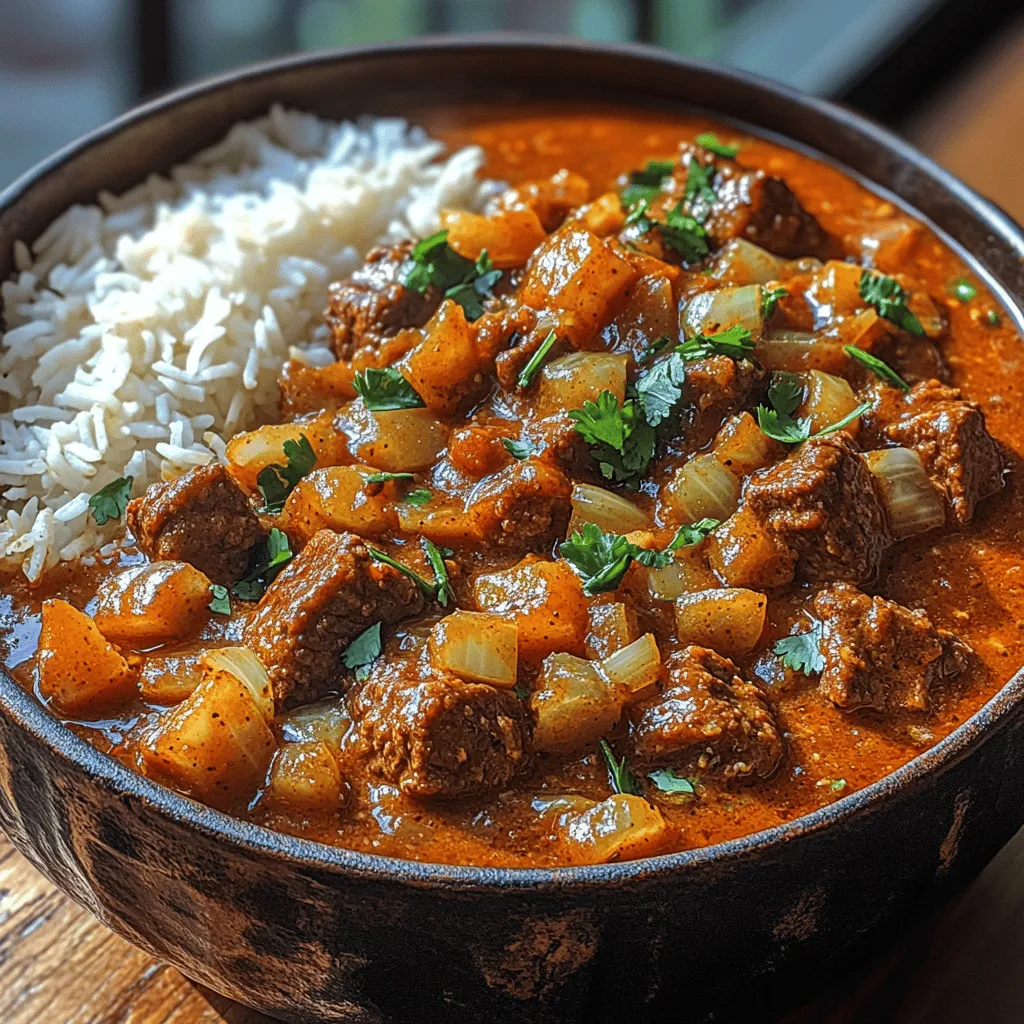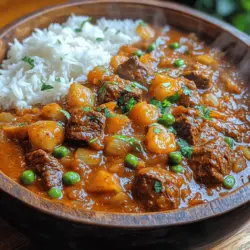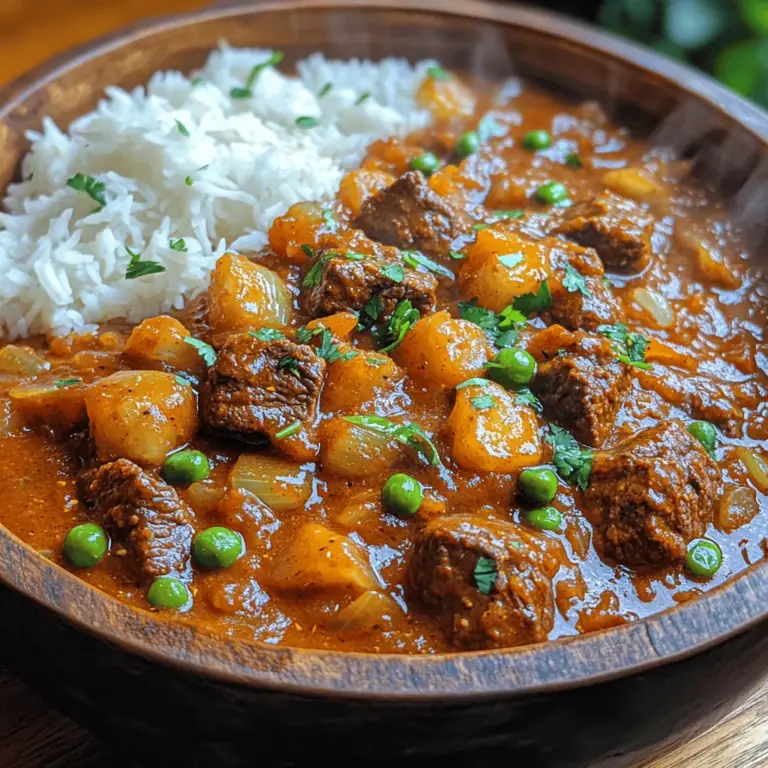Introduction
Beef Vindaloo is more than just a dish; it is a culinary experience steeped in rich history and vibrant flavors. Originating from the coastal region of Goa, this dish has roots that intertwine with Portuguese influences and Indian culinary traditions, making it a standout in Indian cuisine. The term “Vindaloo” is derived from the Portuguese dish “Carne de Vinha d’Alhos,” which translates to “meat marinated in wine vinegar and garlic.” Over time, this dish has evolved, absorbing the spices and cooking methods of the Indian subcontinent, resulting in the bold and spicy creation we enjoy today.
What sets Beef Vindaloo apart is its unique blend of spices and flavors that create a symphony of taste in every bite. The dish is known for its fiery heat, tangy undertones, and aromatic spices, making it a favorite among spice lovers. The combination of vinegar, which adds a tangy depth, and a variety of spices such as cumin, mustard seeds, and coriander, gives Vindaloo its signature flavor profile. For those who relish cooking from scratch, preparing Homemade Beef Vindaloo is not only satisfying but also allows you to control the spice levels and ingredients, crafting a dish that suits your palate perfectly.
Understanding Vindaloo
Origins of Vindaloo: A Historical Perspective
To truly appreciate Beef Vindaloo, one must delve into its historical context. The origins of Vindaloo can be traced back to the 15th century when Portuguese explorers and traders arrived in India. They brought with them their culinary traditions, including the concept of marinating meat in wine and garlic. When the Portuguese settled in Goa, they adapted their traditional recipes to incorporate local ingredients, including spices native to India.
As the dish evolved, it was heavily influenced by the local Goan culture. The substitution of wine vinegar for palm vinegar, along with the addition of Indian spices, transformed the dish into what we recognize today. The Goan version of Vindaloo is known for its heat, thanks to the inclusion of red chilies, while still maintaining the tangy and garlicky essence of the original recipe.
Variations of Vindaloo Across Different Regions in India
While the Goan Beef Vindaloo is the most famous version, various regions in India have their own interpretations of Vindaloo. In Maharashtra, for example, you might find a Vindaloo made with pork, showcasing the region’s affinity for this meat. Bengali Vindaloo often uses mustard oil, giving it a distinctive flavor profile that differs from its coastal counterpart.
In different parts of India, the spice levels, types of meat used, and preparation methods can vary significantly. However, the core essence of Vindaloo—a spicy, tangy, and hearty meat dish—remains consistent across these variations. Each region adds its unique touch, making Vindaloo a versatile dish that reflects the diverse culinary landscape of India.
Key Characteristics that Define a Traditional Vindaloo
A traditional Vindaloo is characterized by its intense flavors and the balance between heat and tanginess. It is a dish that requires patience and careful preparation, as the flavors develop over time. The hallmark of a good Vindaloo is the marination process, which allows the meat to absorb the spices and vinegar, resulting in a tender and flavorful dish.
In terms of texture, Vindaloo typically has a thick, gravy-like consistency that clings to the meat. The use of spices is crucial; they are often ground into a paste that forms the base of the curry, contributing to its depth and aroma. The vibrant color of the dish, often a rich reddish-brown, is a testament to the use of dried red chilies and spices, enticing diners even before the first bite.
Ingredients Breakdown
Beef Vindaloo is a celebration of ingredients that work harmoniously to create a dish bursting with flavor. Let’s take a closer look at the main components that contribute to this delicious recipe.
Overview of the Main Ingredients Used in Beef Vindaloo
1. Beef: The choice of beef is critical to achieving the desired tenderness and flavor. Cuts like chuck roast or brisket are ideal, as they become melt-in-your-mouth tender when slow-cooked. The marbling in these cuts also helps to enhance the richness of the dish.
2. Vinegar: A hallmark ingredient in Vindaloo, vinegar not only acts as a tenderizer but also adds a tangy depth that balances out the rich flavors of the beef and spices. Traditionally, palm vinegar is used, but white or apple cider vinegar can be excellent substitutes.
3. Spices: The spice blend is what makes Vindaloo truly special. Key spices include mustard seeds, cumin, coriander, and turmeric. These spices are often ground together to create a fragrant paste that infuses the meat with flavor. Additionally, dried red chilies contribute heat and a beautiful color to the dish.
4. Coconut Milk: While traditional Vindaloo does not always include coconut milk, it is an optional ingredient that can add creaminess and balance out the spices, especially for those who prefer a milder flavor. The richness of coconut milk can help tone down the heat, making the dish more approachable for a wider audience.
Importance of Each Ingredient
Beef: Choosing the Right Cut for Tenderness
Selecting the right cut of beef is paramount for a successful Vindaloo. A well-marbled cut like chuck or brisket will yield a tender and juicy result after slow cooking. The fat content in these cuts not only enhances the flavor but also helps to keep the meat moist during the cooking process. As the beef cooks low and slow, it absorbs the spices and vinegar, resulting in a dish that is both flavorful and satisfying.
Vinegar: Role in Marination and Flavor Enhancement
Vinegar is a key player in the marination process, helping to tenderize the meat while imparting a distinct tanginess that is essential to the dish’s flavor profile. The acidity of vinegar breaks down the proteins in the beef, allowing it to become tender and flavorful. Additionally, it helps to balance the richness of the spices and beef, creating a well-rounded dish that excites the palate.
Spices: A Closer Look at the Spices Used
The spices in Beef Vindaloo are what elevate this dish to a culinary masterpiece. Mustard seeds add a slight bitterness and depth, while cumin and coriander contribute warmth and earthiness. Turmeric gives the dish its vibrant color and is known for its anti-inflammatory properties. The dried red chilies provide heat, and their level of spiciness can be adjusted based on personal preferences. This careful balance of spices is what makes Vindaloo so memorable.
Coconut Milk: Optional Ingredient for Creaminess and Flavor Balance
Although not a traditional component, coconut milk can be a welcome addition to Beef Vindaloo, especially for those who prefer a creamier texture. It adds a subtle sweetness that can counterbalance the heat from the spices, resulting in a more harmonious dish. If you choose to include coconut milk, consider adding it towards the end of the cooking process to maintain its rich flavor and creamy consistency.
Preparation of the Marinade
The marinade is where the magic begins. Creating the perfect marinade for Beef Vindaloo involves a careful balance of spices, vinegar, and aromatics. Follow this step-by-step guide to prepare a marinade that will infuse the beef with flavor and tenderness.
Step-by-Step Guide to Creating the Marinade
1. Gather Your Ingredients: Start by measuring out your spices. You will need mustard seeds, cumin seeds, coriander seeds, turmeric powder, and dried red chilies. If you prefer a milder flavor, adjust the number of chilies according to your heat tolerance.
2. Toast the Spices: In a dry skillet over medium heat, lightly toast the mustard seeds, cumin seeds, and coriander seeds until fragrant. This process enhances their flavors and oils. Be careful not to burn the spices; a few minutes should suffice.
3. Grind the Spices: Once toasted, transfer the spices to a spice grinder or mortar and pestle. Grind them into a fine powder. Add the turmeric powder and mix well.
4. Prepare the Marinade Base: In a mixing bowl, combine the ground spice mixture with vinegar, garlic, and ginger paste. This paste will form the base of your marinade, providing a robust flavor profile.
5. Marinate the Beef: Cut the beef into bite-sized cubes and place it in a large bowl or resealable plastic bag. Pour the marinade over the beef, ensuring that each piece is thoroughly coated. Massage the marinade into the meat for even flavor distribution.
6. Marination Time: Cover the bowl or seal the bag and refrigerate for at least 4 hours, preferably overnight. The longer the meat marinates, the more intense the flavors will be. This step is crucial for tender, flavorful Vindaloo.
Tips for Achieving the Right Balance of Flavors
– Adjust Spice Levels: If you’re unsure about the heat level, start with fewer dried red chilies in the marinade. You can always adjust the spice levels later during cooking.
– Fresh Ingredients: Use fresh garlic and ginger for the best flavor. Pre-packaged pastes can lack the depth of flavor that fresh ingredients provide.
– Taste and Adjust: Before cooking, taste the marinade and adjust the seasoning as necessary. You can add more vinegar for tanginess or more spices to enhance the flavor.
Importance of Marinating Time for Flavor Infusion
Marinating the beef is one of the most crucial steps in the Vindaloo preparation process. The longer the meat marinates, the more it absorbs the flavors of the spices and vinegar. A minimum of 4 hours is recommended, but overnight marination is ideal for achieving maximum flavor and tenderness. This crucial step allows the vinegar to break down the meat fibers, resulting in a dish that is not only flavorful but also tender and juicy.
By taking the time to prepare the marinade properly, you elevate your Beef Vindaloo from a simple curry to an unforgettable culinary experience. The next steps will involve cooking the marinated beef to perfection, but for now, the foundation of flavor has been established, setting the stage for a truly remarkable dish.

Cooking the Vindaloo
To create a truly authentic Beef Vindaloo, the cooking process is just as crucial as the ingredients. Begin by heating a large, heavy-bottomed pot or Dutch oven over medium heat. Once hot, add a couple of tablespoons of vegetable oil or ghee. The choice between oil and ghee can slightly alter the flavor profile, with ghee adding a rich, nutty taste that complements the spices wonderfully.
Next, it’s time to sauté the onions. This step is essential for developing the base flavor of your vindaloo. Finely chop two large onions and add them to the pot. Stir occasionally, allowing the onions to soften and caramelize. You want them to turn golden brown, which typically takes about 10-15 minutes. The browning process releases natural sugars, creating a sweet base that balances the spices’ heat.
While the onions are cooking, it’s a good idea to prepare your beef. Use around 2 pounds of beef, preferably chuck or brisket, cut into 1-inch cubes. Before adding the beef to the pot, pat it dry with paper towels. This step is crucial for achieving a good sear. Once the onions are caramelized, increase the heat to medium-high and add the beef to the pot in batches to avoid overcrowding. Browning the beef enhances its flavor and seals in juices, ensuring a succulent bite. Cook until the beef is browned on all sides, about 5-7 minutes per batch.
Once all the beef is browned, it’s time to add the spices. You should have prepared a spice blend that includes ground turmeric, cumin, coriander, and the star of the show, a generous amount of Vindaloo spice mix, which can include a combination of dried red chilies, cloves, cinnamon, and black pepper. Sprinkle the spices over the beef and onions, stirring well to coat the meat evenly. This step releases the essential oils from the spices, providing a fragrant aroma that permeates the dish.
Next, add two medium-sized chopped tomatoes to the pot. The acidity from the tomatoes is crucial, as it balances the richness of the beef and the heat from the spices. Stir the mixture well, allowing the tomatoes to break down and meld with the other ingredients for about 3-5 minutes. You’ll notice a lovely, thick sauce beginning to form.
Simmering to Perfection
Once the base is prepared, it’s time to simmer the vindaloo. This step is critical for developing deep flavors and tenderizing the beef. Pour in 1 to 1.5 cups of water, just enough to cover the beef without making it soupy. The simmering process allows the flavors to blend beautifully, transforming the dish into a comforting, rich curry.
If you prefer a creamier texture, you can substitute half of the water with coconut milk. This addition not only enhances the flavor but also provides a wonderful richness that balances the spices. After adding your liquid, bring the mixture to a gentle boil, and then reduce the heat to low. Cover the pot and let it simmer for at least 1.5 to 2 hours. Stir occasionally to prevent sticking and to ensure even cooking.
During this time, it’s essential to monitor the beef’s tenderness. After about an hour, check the meat. It should begin to break apart easily when you pull it with a fork. If it’s not quite there yet, continue to simmer, checking every 15-20 minutes. The goal is to achieve melt-in-your-mouth beef that absorbs all the wonderful flavors of the vindaloo sauce.
Finishing Touches and Presentation
As the cooking time comes to an end, it’s time for the finishing touches. Before serving, taste the vindaloo and adjust the seasoning as needed. You may want to add a pinch of salt or a touch of sugar to balance the acidity of the tomatoes and the heat from the spices. A splash of vinegar or lime juice can also brighten the flavors significantly, enhancing the dish’s overall complexity.
For presentation, serve your Beef Vindaloo in a vibrant bowl, garnished with fresh cilantro leaves for a pop of color and a hint of freshness. Consider serving it alongside fluffy basmati rice, which is perfect for soaking up the rich sauce, or with warm naan bread for a traditional touch. If you want to elevate the meal further, consider pairing your vindaloo with a side of cucumber raita, a cooling yogurt-based dish that counteracts the heat.
Cultural Significance of Vindaloo
Vindaloo is not just a dish; it’s a celebration of Indian culture and heritage. Originating from the Portuguese dish “Carne de Vinha d’Alhos,” which translates to “meat marinated in wine and garlic,” vindaloo has evolved over the centuries, particularly in the Indian state of Goa, where spices and flavors intermingle to create this beloved curry.
This dish is often served during festive occasions and family gatherings, signifying warmth and hospitality. In India, food is deeply rooted in tradition, and vindaloo is a prime example of how flavors can tell a story. Whether enjoyed during a family feast or a casual dinner, this dish brings people together, reflecting the diverse culinary landscape of India.
Many families have their own versions of the recipe, passed down through generations. Sharing stories of enjoying vindaloo at family gatherings or celebrations, such as weddings and festivals, adds a personal touch to the dish. The act of cooking and sharing food creates bonds and enriches relationships, reminding us of the importance of home-cooked meals.
Conclusion
Making Beef Vindaloo at home is a rewarding experience that brings together the joy of cooking and the satisfaction of indulging in a rich, flavorful dish. By following the steps outlined, you can create a vindaloo that not only tantalizes your taste buds but also connects you to the vibrant culture and traditions of India.
I encourage you to explore and experiment with traditional recipes. Each variation tells a different story and reflects the unique ingredients and culinary practices of various regions. Home-cooked meals are not just about nourishment; they are a way to connect with our heritage and share love through food.
As you savor each bite of your homemade Beef Vindaloo, remember that you’re not just enjoying a meal, but also participating in a rich cultural narrative that spans generations. Embrace these moments, and let your kitchen become a space where flavors, stories, and traditions come to life.

